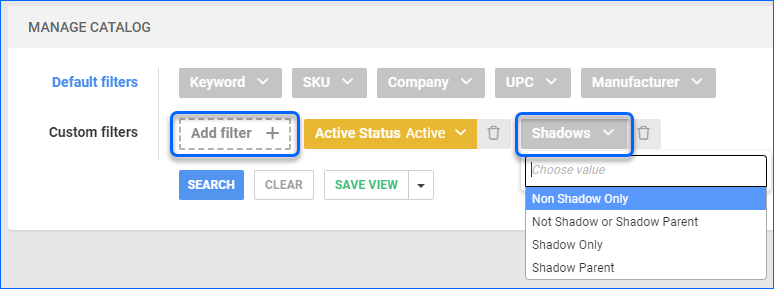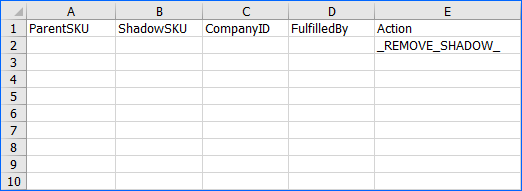Overview
A Shadow Product is an alternative product profile for an item. Creating a shadow lets you manage separate listings and details for a single product and is often used when maintaining multiple listings for a product on a single marketplace or when managing multiple fulfillment settings for a product.
Shadow Use Cases
A parent SKU can have one profile, whereas the shadow SKU can have a different Product ID, description, images, and title. That is an innovative and handy way to list a product in alternative venues.
Amazon and eBay allow a single SKU to be listed only once under one category. The product can be listed in multiple categories by creating a Shadow SKU or various shadows.
When selling the product to multiple companies, ProductIDs must be unique. A product can only be associated with a single company, so Shadow SKUs can be used to link products from numerous companies.
You can share Product details such as title and description from parent to shadows based on shadow persistency settings, which keeps product information consistent between profiles.
Creating shadows to list a product on multiple channels within one company is not necessary.
Create and Manage Shadows
You can create shadows individually, via file import, or in bulk.
Individually
- Open a product and go to Toolbox > Shadows.
- From here, you can also view the existing shadow relationships.
- Select Assign Parent SKU to choose a parent SKU. To add shadows, click Add Shadows.

- If you select Assign Parent SKU, search for the product > add filters (if necessary) > select the item > and press Assign.

- If you select Add Shadows, select Enter SKU to create new Shadow SKUs or Existing products to assign existing SKUs as shadows.

Via File Import
You can easily bulk-import Shadow Products using the Import Product Shadows Template file.
- Go to Catalog > Tools > Import Product Info.
- You can either import your own file or download the template.

- Insert the product information into the file columns as follows:
- Parent SKU – Enter the main SKU of the product.
- Shadow SKU – Enter the alternate SKU (e.g., for another ASIN or for a product from another company).
- Existing Product IDs in your catalog entered under this column will be linked to parents as shadows. Product IDs that do not exist in your catalog will be created and linked to the defined parent as a shadow.
- Company ID (optional) – Enter the company the shadow is associated with.
- Fulfilled By (optional) – Enter either Amazon or Merchant.
- Action (optional).

- Once you upload the file, click Import.
You can enter a non-existing shadow SKU under the Shadow SKU column of the template. A new product will be created and linked to the defined parent in the Parent SKU column as a shadow.
Click to download the Excel template.
This will generate a queued job. Once the job is complete, the shadow SKUs will be created along with the shadow relationships.
When viewing a parent SKU, all shadows will be displayed in the Shadows panel. Click Manage Shadows to edit the shadow configuration. When viewing a shadow product, the parent SKU will be referenced with a link right below the Shadow’s Product Name.
In Bulk
Navigate to Catalog > Manage Catalog > Choose products > Action Menu > Create Shadows.
- Select your desired shadow parent(s) and press the Action icon.
- Press Create Shadows and fill in the credentials. Press Create.

- You should enter a prefix or suffix for the shadow. If the shadow’s parent SKU is ABC and the prefix is 123, the shadow SKU will be 123ABC. If the suffix is 123, then the shadow SKU will be ABC123.
From Catalog > Manage Catalog, you can search for shadow-related products by selecting the custom filter Shadows and selecting an option from its drop-down menu.
Disconnect and Remove Shadow Relationships
You can disconnect or remove shadow relationships individually, via file import, or in bulk.
Individually
Open your shadow or parent product and go to Toolbox > Shadows. Then, select Disconnect from this parent SKU (in the shadow) or Unlink (in the shadow parent).
Via File Import
You can use the Import Product Shadows Template file to un-shadow products in bulk by entering this exact text in the Action column: _REMOVE_SHADOW_. This action will unlink a shadow SKU from a shadow parent.
In Bulk
You can also remove shadow relationships in bulk from the Manage Catalog page by selecting a shadow SKU(s) and pressing the Action menu > Unshadow from Parent.
Shadow Properties and Inventory Specifics
The Shadow Inventory mirrors the available Parent Inventory, and the total Inventory summed between all products display on the Product Home page. This Inventory is also the quantity used when updating Inventory to channels.
Exceptions
There are two exceptions to the rule (when Inventory is not controlled under the parent):
- When you have FBA Inventory or WFS Inventory.
- In such cases, where Amazon or Walmart hold your inventory and fulfill orders, the Inventory will always show in the SKU marked as Fulfilled by Amazon/WFS Enabled, regardless of if the SKU is a Shadow or a Shadow Parent.
- In cases where you don’t have the Always deduct Inventory from Shadow Parent setting enabled
- In these cases, if you have negative values in the shadow aggregate quantity, you can navigate to the Action menu on the Manage Inventory page and merge the shadow inventory into the parent inventory (Merge Shadow Inventory).
Kits and Shadows
A product can be shadowed to a kit. However, this is rarely recommended since it will copy the inventory dependency to the shadow product.
An example scenario would be shadowing Merchant Fulfilled and Amazon Fulfilled products that are also kits. Whenever the Merchant Fulfilled product is an All Component or Main Component kit, it should not be shadowed to the Amazon Fulfilled SKU. That is because the Amazon Fulfilled product should be an Independent Kit to manage Inventory properly.
Overview
A Shadow Product is an alternative product profile for an item. Creating a shadow lets you manage separate listings and details for a single product and is often used when maintaining multiple listings for a product on a single marketplace or when managing multiple fulfillment settings for a product.
Shadow Use Cases
A parent SKU can have one profile, whereas the shadow SKU can have a different Product ID, description, images, and title. That is an innovative and handy way to list a product in alternative venues.
Amazon and eBay allow a single SKU to be listed only once under one category. The product can be listed in multiple categories by creating a shadow SKU or various shadows.
When selling the product to multiple companies, ProductIDs must be unique. A product can only be associated with a single company, so shadow SKUs can be used to link products from numerous companies.
You can share Product details such as title and description from parent to shadows based on shadow persistency settings, which keeps product information consistent between profiles.
Creating shadows to list a product on multiple channels within one company is not necessary.
Create and Manage Shadows
You can create shadows individually, via file import, or in bulk.
Individually
In Bulk
Navigate to Inventory > Manage Inventory > Choose Products > Action Menu > UnShadow > Go > Continue.
Via File Import
You can easily create shadows in bulk using the Import Product Shadows Template file.
- Go to Inventory > Manage Inventory > Import Product Info > Import Shadows.
- You can either import your own file or download the template.

- Insert the product information into the file columns as follows:
- Parent SKU – Enter the main SKU of the product.
- Shadow SKU – Enter the alternate SKU (e.g., for another ASIN or for a product from another company).
- Existing Product IDs in your catalog entered under this column will be linked to parents as shadows. Product IDs that do not exist in your catalog will be created and linked to the defined parent as a shadow.
- Company ID (optional) – Enter the company the shadow is associated with.
- Fulfilled By (optional) – Enter either Amazon or Merchant.
- Action (optional)

- Once you upload the file, click Import Shadows.
Click to download the Excel template.
This will generate a queued job. Once the job is complete, the shadow SKUs will be created along with the shadow relationships.
When viewing a parent SKU, all shadows will be displayed in the Shadows panel. Click Manage Shadows to edit the shadow configuration. When viewing a shadow product, the parent SKU will be referenced with a link right below the Shadow’s Product Name.
Disconnect and Remove Shadow Relationships
You can disconnect or remove shadow relationships individually, via file import, or in bulk.
Individually
Open your shadow or parent product and go to Toolbox > Shadows > Check the tickbox under Disconnect Shadow Persistancy > Remove > Update Shadow Persistancy.
Via File Import
You can use the Import Product Shadows Template file to un-shadow products in bulk by entering this exact text in the Action column: _REMOVE_SHADOW_. This action will unlink a shadow SKU from a shadow parent.

In Bulk
You can also remove shadow relationships in bulk from the Manage Catalog page by selecting a shadow SKU(s) and pressing the Action menu > Unshadow from Parent.
Shadow Properties and Inventory Specifics
The Shadow Inventory mirrors the available Parent Inventory, and the total Inventory is summed between all products display on the Product Home page. This Inventory is also the quantity used when updating Inventory to channels.
Exceptions
There are a few exceptions to the rule (when Inventory is not controlled under the parent):
- When you have FBA Inventory or WFS Inventory.
- In such cases, where you’re shipping products from Amazon or Walmart, the Inventory will always show in the shadow.
- In such cases, where Amazon or Walmart hold your inventory and fulfill orders, the Inventory will always show in the SKU marked as Fulfilled by Amazon/WFS Enabled, regardless of if the SKU is a Shadow or a Shadow Parent.
- In cases where you don’t have the Always deduct Inventory from Shadow Parent setting enabled, and there’s a negative value in the shadow aggregate quantity, you can navigate to Manage Inventory > Action Menu > Merge Shadow Inventory and merge the shadow inventory into the parent inventory.
Kits and Shadows
A product can be shadowed to a Kit. However, this is rarely recommended since it will copy the inventory dependency to the shadow product.
An example scenario would be shadowing Merchant Fulfilled and Amazon Fulfilled products that are also kits.
Whenever the Merchant Fulfilled product is an All Component or Main Component kit, it should not be shadowed to the Amazon Fulfilled SKU. That is because the Amazon Fulfilled product should be an Independent Kit to manage Inventory properly.


